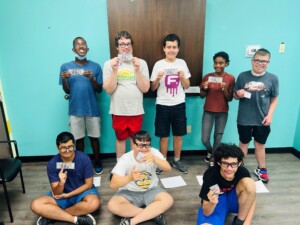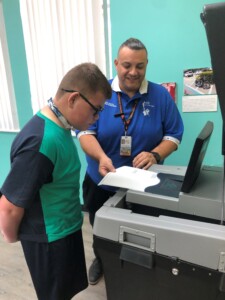By Matthew Louis LaGassa and Embry Burton Published June 8, 2023
Reviewed by Victoria Wells
About the Authors
Matthew Louis LaGassa (born March 2002) was diagnosed Autistic when he was two years old, and has always thought of his neurodivergency as a core part of his identity. Outside of his internship here at CIL, he’s a soon-to-be Senior year student at Rollins College, majoring in in English and minoring in Writing, with a knack for analytical essay writing. In his spare time, he enjoys reading, videogames, tabletop roleplaying games, and baking.
Embry Burton (she/they) is a sophomore at Rollins College involved in the Bonner Leaders Program. They are planning on double majoring in biology and psychology. Embry enjoys reading, volunteering, and feeding the cats on campus. They feel particularly passionate about the topic of the intersectionality between disability inclusion and LGBTQ+ pride because of their identity as nonbinary, pansexual, and someone with a chronic joint illness.
Pride and Disability: The Overlap in Community and Activism
Happy Pride Month from the Center of Independent Living in Central Florida (CIL)! As the LGBTQ+ community all across the country is gathering to uplift each-other’s voices in the fight for their rights, we’ve been hard at work this week doing the same, albeit with an intersectionality-fueled twist. We’ve previously documented how the Independent Living Movement, the cornerstone of our ethos, shares its roots with the African American Civil Rights movement, and similarly, both our community and movement have much overlap with the equally storied history of LGBTQ+ community and activism. Looking at the statistics and activists of the past and present, it’s clear that it’s an overlap that deserves to be highlighted.
The Statistics: Community Overlap
Beginning with reviewing the overlap in our communities, it is evident that people with disabilities make up much more of the LGBTQ+ community than they do their cisgender heterosexual counterparts. Among the approximately seventeen million people that make up the LGBTQ+ community, around five million (roughly thirty six percent of the community) are estimated to be people with disabilities as well (Pauli, 2021; Human Rights Campaign, n.d).
Further studies break this estimated five million down further via percentages: thirty percent of queer men and thirty six percent of queer women self-identify as people with disabilities (Pauli). Breaking down the data even further among individual sexual orientations and gender identities, fifty two percent of transgender people self-report having a disability, as do gay and bisexual men at twenty-six and forty percent respectively, with lesbian and bisexual women both at thirty six percent (Human Rights Campaign; Pauli; DeVault, 2023). Overall, studies like these affirm that queer people are more likely to identify as having disabilities than the general population, and naturally, from such a wide overlap, many activists with a foot in both sides of it have rose throughout this shared history.
Audre Lorde: Blind, Lesbian, Black, Feminist, Poet, Essayist, Activist.
Predating even the 1969 Stonewall Riots, Audre Lorde shines as one of the earliest figures in this storied history of intersectional activism. Born to a poor immigrant family in New York on February 8, 1934, Audre was legally blind due to being short sighted (Holder, 2021). She found success as a poet in her teens, and continued to write and present her poems, as well as essays, in adulthood as a Columbia University graduate and Librarian in New York Public Schools (Holder; Poetry Foundation, n.d.). It was these experiences as Black Lesbian with a disability in straight white male academia that became the foundation of her activism, where she specialized in the intersection between queer theory, feminist theory, and critical race studies, most prevalent in her essay, “The Master’s Tools Will Not Dismantle the Master’s House,” (Poetry Foundation).
She was a staunch figure in movements confronting racism, sexism, classism, and homophobia for decades, where her writing continued to ring “with passion, sincerity, perception, and depth of feeling,” (Poetry Foundation). Sadly, Audre was diagnosed with breast cancer in 1977, but she never stopped writing: her 1980 self-reflection on the latter condition, The Cancer Journals, went on to win American Library Association’s Gay Caucus Book of the Year Award in 1981 (National Museum of African American History & Culture, 2020). Sadly, six years after that diagnosis, Audre was diagnosed with liver cancer, and passed away on November 17, 1992 (National Museum of African American History & Culture).
With a storied legacy like that, Audre Lorde certainly deserves her legacy today as “A ‘self-described ‘black, lesbian, mother, warrior, poet,’” and so much more, and it wouldn’t be long until many more activists would come to follow in her steps, no where matter where they went (Poetry Foundation).
Bobbie Lea Bennet: Trans Woman, Wheelchair, Courageous
With Transgender people in many states at risk of losing their access to gender affirming care, Bobbie Lea Bennet’s story of taking the fight straight to the top is as timely as ever. Born in Louisiana on March 31, 1947, Bobbie was a United States Medicare recipient for her use of a wheelchair. With this unique position, Bobbie successfully mobilized media coverage in support of her to confront the system’s lack of coverage for cover gender affirming surgeries, spurned her own request for Medicare to cover it being denied with no explanation (Transjoy, 2023; Phoenix, 2022). In 1978, after a cross country road trip from San Diego, California, to Baltimore, Maryland, Bobbie made her case to Medicare’s director at the time, Thomas M. Tierney, and won, obtaining gender affirmation surgery as a trans woman at last (Transjoy).
Bobbie continued her activism in 1985 by founding the St. Tammany Parish Organization for the Handicapped to serve the needs of people with disabilities in the eponymous Louisiana Parish, but has sadly since been dissolved (Transjoy). Bobbie continued to live a long life of activism for both LGBTQ+ and disability rights, passing away on July 18, 2019. Alongside countless other intersectional activists’ stories, Lorde and Bennet’s legacies live on today in more recent figures.
Lydia X. Z. Brown: Non-Binary, Living at the Intersection, Writer, Activist, Scholar, and Attorney
Moving up to modern times, the Chinese American Lydia X. Z. Brown, they/them or no pronouns, stands out for their many skills as a “writer, public speaker, educator, trainer, consultant, advocate, community organizer, community builder, activist, scholar, and attorney” (Brown, n.d.). They are incredibly involved and accomplished in their local and national community as leader of the “Fund for Community Reparations for Autistic People of Color’s Interdependence, Survival, and Empowerment… an adjunct lecturer and core faculty in the Disability Studies Program and the Women’s and Gender Studies Program at Georgetown University, and as an adjunct professorial lecturer in the American Studies Program at American University’s Department of Critical Race, Gender, and Culture Studies.” Among these and many other impactful roles, they are also the “Director of Policy, Advocacy, and External Affairs at the Autistic Women and Nonbinary Network” (Brown).
Having “worked to address and end interpersonal and state violence targeting disabled people, especially disabled people at the margins of the margins… of disability, queerness, race, gender, class, and nation and migration,” for over a decade, Lydia shows no signs of stopping anytime soon, and neither does this last group.
Drag Syndrome: A Royal Ensemble of Down Syndrome Artists
Closing out our litany of recognition with “The new queer cultural heroes,” Drag Syndrome, a “drag collective featuring highly addictive queens and kings with Down-Syndrome,” these of creative artists celebrate gender expression, sexuality, and their identities as people with Down-Syndrome (Drag Syndrome, n.d.). With art as their starting point before anything else, and country-to-country tours, Drag Syndrome has been featured in many major news outlets, including BBC, The New York Times, and NBC, spreading their message of acceptance and inclusivity far and wide, and where honored to do the same.
Conclusion:
As we pride ourselves in being inclusive of every person it is important that we better understand these struggles, alongside the ones many further face as people with disabilities, hold fast to the figures that both have, and are still fighting, to push back against such bigotry, and make their courage our own. In the spirits of Audre Lorde, Bobbie Lea Bennet, Lydia X. Z. Brown, Drag Syndrome, and countless others like them, we at The Center for Independent Living stand with all queer people with disabilities, and are here for them, so that they may find the help they need to live safe and fully independent lives.
Works Cited:
Audre Lorde. National Museum of African American History and Culture. (2020, May 29). https://nmaahc.si.edu/audre-lorde
Brown, L. (n.d.). About. Lydia X Z Brown. https://lydiaxzbrown.com/about/
DeVault, N. (2023, March 10). Study affirms LGBTQ people are more likely to have a disability than the general population – ameridisability. The Latest National Disability News. https://www.ameridisability.com/study-affirms-lgbtq-people-are-more-likely-to-have-a-disability-than-the-general-population/
Drag syndrome. Drag Syndrome. (n.d.). https://www.dragsyndrome.com/
Holder, D. (2021, August 24). Audre Lorde, warrior poet. DisHistSnap. https://www.disabilityhistorysnapshots.com/post/audre-lorde-warrior-poet
Pauli, P. (2021, June 2). Celebrating approximately 5 million LGBTQ+ people with disabilities for pride 2021. RespectAbility. https://www.respectability.org/2021/06/pride-month-2021/
Phoenix 1 year ago1 year ago, B. (2022, February 25). LGBT+ History month X disabled students group – Bobbie Lea Bennett. THE HOOT. https://thehootstudents.com/lgbt-history-month-x-disabled-students-group-bobbie-lea-bennett/
Poetry Foundation. (n.d.). Audre Lorde. Poetry Foundation. https://www.poetryfoundation.org/poets/audre-lorde
TransJoy. (2023, April 5). LGBT+ figures in history #5: Bobbie Lea Bennett. TransJoy. https://www.transjoy.co/2022/03/01/bobbie-lea-bennett/
Understanding disability in the LGBTQ+ community. Human Rights Campaign. (n.d.). https://www.hrc.org/resources/understanding-disabled-lgbtq-people


